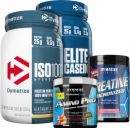
The Science Of Swole
Lifting weights can help you build size, but few lifters actually understand how it works. To get the most out of your workouts, it's time you understand hypertrophy—and the science behind swole.
When it comes to increasing muscle mass, there's a lot of information—and a lot of opinions—on the best way to increase size. And while it's not a one-size-fits-all kind of thing, understanding the science behind resistance training and building muscle can help you achieve better results in the gym.
For those who are new to resistance training, muscle hypertrophy (growth) is virtually nonexistent during the initial stages of resistance training, with the majority of strength gains resulting from neural adaptations. That is, gains you see early on in the first 4-6 weeks are mostly the result of improved coordination and your muscles learning to fire together, rather than actual increases in the size and strength of the muscle fibers. "Understanding this benefit progression is important for people who are new to resistance training" says Dr. Rob Wildman, chief science officer for Dymatize Nutrition. "Staying focused and committed to training hard will lead to bigger benefits in the weeks that follow."
Then you start seeing changes in your muscles. Within a couple months of consistent training, hypertrophy takes over, with muscles of the upper body showing noticeable increases in size before the lower body. Novice lifters can expect to gain around 2.5 pounds of muscle per month for the first few months. Keep in mind that genetics, gender, and other factors can affect both the rate and total amount of gains in muscle mass, and not everyone is created equally in the gains department.
For seasoned lifters, those gains become a lot harder to come by. As one becomes more experienced with weight training, it becomes progressively more difficult to put on size and strength. Instead of packing on a couple pounds of muscle each month, you're looking at half a pound—or even worse, a plateau. That's where proper routine design becomes of utmost importance if you want to continue increasing your muscle mass!
Mechanisms of Hypertrophy
Exercise-induced hypertrophy is facilitated by a complex cascade of anabolic and catabolic signaling pathways, resulting in a shift favoring muscle protein synthesis over breakdown. Currently, it's believed that there are three basic factors—mechanical tension, muscle damage, and metabolic stress—required to promote muscle hypertrophy.
Mechanical tension probably has the most influence on muscle hypertrophy.2 It's thought that high-intensity resistance training disturbs the integrity of skeletal muscle, causing molecular and cellular responses in muscle and satellite cells.3 These responses result in growth.

With regard to resistance training, the optimal combination of load (weight being used) and time under tension (the length of your set) will maximize muscle-fiber recruitment, thus leading to greater muscle hypertrophy. Unfortunately we don't yet know the "optimal combination." However, you'll need to lift above the threshold of 60-65 percent of your 1RM to see noticeable changes in muscle size.4 That means if you're using a weight you can do more than about 12 reps with, it's too light to maximize gains.
Muscle damage, which can be caused by resistance training, is thought to be the second factor leading to muscle growth. Following a session with the weights, your body initiates an inflammatory response, leading to the production of proteins called myokines.3,5 These proteins help release growth factors necessary for hypertrophy.
"Muscle damage is also tied into muscle soreness," says Dr. Wildman. "And while some damage can help maximize gains the goal shouldn’t be to overtrain, which can cause excessive damage of the muscle leading to slower recovery and disruption of achieving acute training quality and volume over time."
Metabolic stress is the final player when it comes to promoting hypertrophy. Metabolic stress occurs when your body relies primarily on anaerobic glycolysis for the production of energy. This would be typical of a bodybuilding-style workout that relies on an energy pathway that's high in intensity and doesn't require oxygen.
This leads to the accumulation of metabolites (hydrogen ions, lactate, and inorganic phosphate), which set the stage for anabolic hormones such as insulin-like growth factor (IGF-1), testosterone, and growth hormone to stimulate muscle protein synthesis.6,7
5 Variables to Optimize Hypertrophy
Proper manipulation of training variables is essentials for maximizing muscle hypertrophy. Here are five important training variables to consider when designing your program.
Intensity
Training intensity is arguably the most important exercise variable for stimulating muscle growth.8 Commonly expressed as a percentage of your single-rep max (1RM), intensity equates to the number of repetitions you can perform with a given weight. The heavier the weight, the fewer reps you can do.
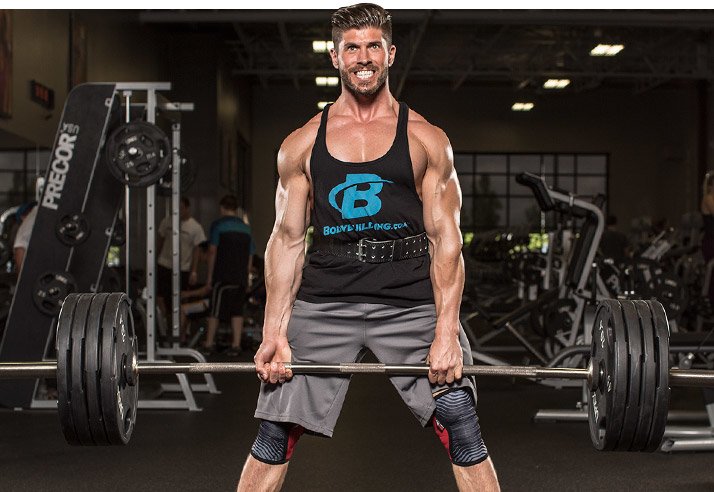
Moderate rep ranges (6-12) have been shown to optimize the hypertrophic response, with loads less than 65 percent of 1RM not considered sufficient to optimize muscle growth.4 Studies of bodybuilding-style exercise routines performed with multiple sets of 6-12 have demonstrated post-exercise increases in metabolites, like lactate and glucose, which have a significant impact on anabolic processes.9
"Muscle damage is also tied into muscle soreness," says Dr. Wildman. "And while some damage can help maximize gains, the goal shouldn’t be to overtrain, which can cause excessive damage of the muscle leading to slower recovery and disruption of achieving acute training quality and volume over time."
Both testosterone and growth hormone are elevated to a greater degree in training programs that employ moderate-rep (6-12) sets as compared to high-intensity sets using lower rep ranges.10,11 Moreover, the increased time under tension associated with moderate rep ranges is ideal for causing fatigue across the full spectrum of muscle fibers, maximizing increases in muscle size.8
Volume
Higher-volume, multiple-set protocols have consistently proven to be superior over single sets when it comes to muscle hypertrophy.12,13 High-volume programs that generate a significant amount of glycolytic activity (think bodybuilding-style programs, which are anaerobic in nature) elevate testosterone and growth hormone levels to a greater extent than low-volume routines do.11,14
A split routine, where you perform multiple exercises for a specific muscle group, may be more beneficial for a hypertrophic response compared to full-body routines.15 Split routines allow you to focus on one or two muscle groups per workout, maintaining total weekly volume, but with fewer working sets per session compared to a full-body workout. Since you'll only be hitting each muscle group once per week, you'll also have a greater recovery period.16
This may enable the use of heavier training loads in a workout, which generates greater muscular tension, potentially increasing the acute anabolic hormonal response.
Exercise Selection
When it comes to muscle size, multijoint exercises are key. Such movements recruit a large amount of muscle mass, which has a huge impact on hormone response. Higher levels of both growth hormone and testosterone have been reported following multijoint movements compared to single-joint ones.17,18
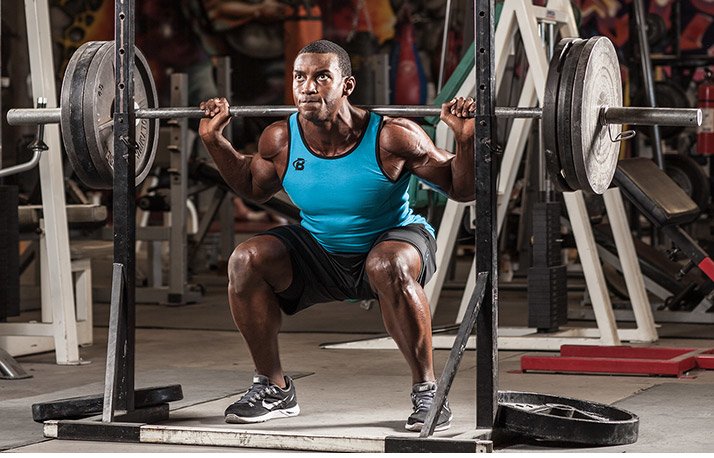
This doesn't mean you can't include single-joint movements in your program. These so-called isolation exercises are great for targeting underdeveloped muscles and improving muscular symmetry. Additionally, targeting individual muscles can elicit differing neuromuscular activation patterns—and doing so may heighten overall muscular development.19
Rest Interval
Rest intervals between sets can be classified into three categories: short (30 seconds or less), moderate (60-90 seconds), and long (three minutes or more). Short recovery periods don't allow sufficient time to regain muscle strength, and long rest intervals compromise metabolic stress. Instead, moderate rest is best for maximizing the hypertrophic response.1
Compared to short and long rest periods, moderate rest intervals are associated with a greater metabolic buildup, leading to a large spike in anabolic hormones after exercise.11
Training to Failure
Muscular failure is defined at the point during a set when a muscle can no longer produce the necessary force to lift the weight for one more rep. Training to failure not only activates a larger number of muscle fibers but also enhances exercise-induced muscle stress, elevating the hypertrophic response.20
Techniques to Take Your Training to the Next Level
Clearly, training to failure is a key component to build muscle. But what about advanced training techniques that allow you to train past failure, and other ways to manipulate your workout to make it harder? Let's take a look.
Forced Reps
Forced reps, sometimes described as assisted reps, involve the use of a training partner to help you perform a few additional reps after complete failure is reached. The idea here is that the forced reps increase the amount of metabolic stress your muscles are under, providing additional stimulus for growth.
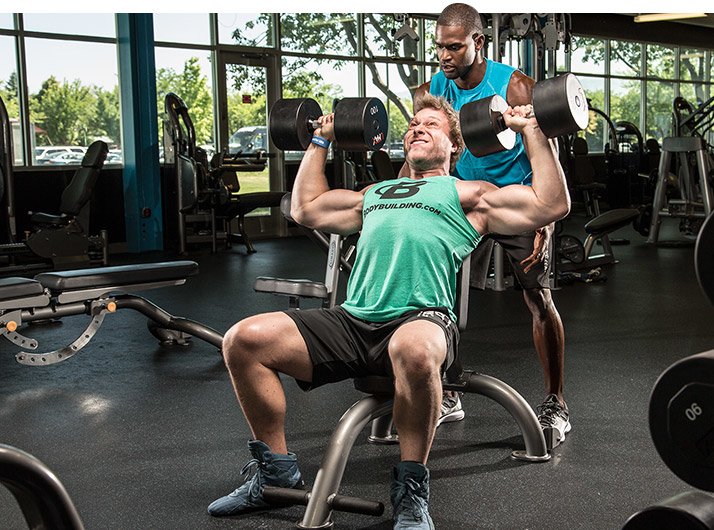
Researchers in Finland put this theory to the test. They had two groups perform 4 sets of 12 repetitions for the squat and leg extension; one group used their 12RM and the other group used a load heavier than even their 1RM so that assistance was required to complete all 12 reps. They found that growth-hormone levels were significantly higher in the forced-rep group compared to the group that didn't perform any forced reps.21
Although there's some disagreement when it comes to the anabolic role of growth hormone during exercise, studies indicate that an increase in growth hormone following exercise is highly associated with both muscle-fiber hypertrophy and strength-related muscular adaptations.
Dropsets
Another post-failure technique many bodybuilders use is the dropset. Dropsets involve performing a set to failure with a given load and then immediately reducing the load and continuing to crank out more reps until you hit failure again.
The increased time under tension induces greater muscular fatigue than a standard straight set, and the heightened metabolic stress can help to enhance the anabolic environment. In fact, studies have shown significant spikes in growth-hormone levels following dropsets, as well as an increase in muscle size compared to a training protocol using only standard straight sets.22,23
Dropsets are a great technique to incorporate into your program to maximize growth, and unlike forced reps they can be done without a partner. If you're up for the challenge, try doing multiple drops in the same set to elicit even greater levels of fatigue and metabolic stress!
While both dropsets and forced reps are great training tools to have in your arsenal, repeatedly training to muscle failure can increase the potential for overtraining and burnout. Over time, this can lead to a decrease in anabolic hormones, like testosterone.24 I recommend using dropsets and forced reps sparingly. Limit their use to a select few exercises while also incorporating periods of lower volume to allow for proper rest and recovery for your muscles.
Supersets
A superset is simply a pair of exercises that are alternated without rest. Not only will this training technique save you some time in the gym, but research has demonstrated greater increases in energy expenditure and lactate accumulation by using supersets over traditional sets.25
Although any two exercises can be paired together to form a superset, the most common technique involves pairing exercises that share an agonist/antagonist relationship (think biceps curls and triceps extensions).
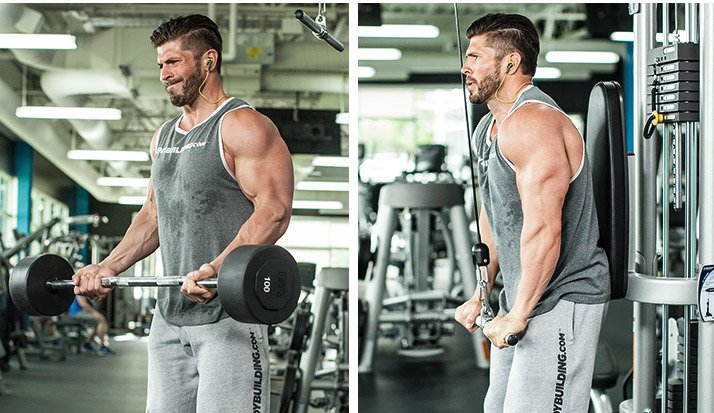
Several studies have shown that this technique can actually increase force output during agonist contraction because of reduced inhibition by the antagonist muscle and an increase in stored elastic energy within the muscle.26,27 That means if you precede your biceps curl with a set of press-downs for triceps, you may actually be able to generate more force! An increase in force means greater mechanical tension and more muscular growth.
This technique also allows for a greater number of reps to be performed without having to significantly reduce the intensity. If you haven't caught on yet, higher intensity equals more fatigue, and more fatigue leads to a greater anabolic response.
Negatives
Up to this point, most of the focus has been on techniques that primarily involve concentric (or positive, lifting the weight) muscle actions. Heavy negatives are all about the eccentric movement—lowering the weight—and involve loads greater than your 1RM to completely fatigue the muscle. That's because you're stronger lowering a weight than lifting it, so you can really load up the negative.
Numerous studies show greater gains in muscle mass with eccentric training compared to concentric only.28,29 One of the reasons for this is the greater muscle damage that occurs with eccentric training. Damage to the muscle is believed to promote a hypertrophic response, leading to a rapid rise in protein synthesis.
Eccentric training can also recruit more type II (fast-twitch) muscle fibers, which have the greatest potential for hypertrophy. This was demonstrated in a study published in the Journal of Applied Physiology that found eccentric training resulted in a tenfold increase in muscle size compared to concentric exercise.30

Finally, eccentric training has been shown to elevate lactate levels, resulting in an increased anabolic hormone response.31
There's more than one way to do negatives, but here's my recommendation: Perform them with a load between 105 and 125 percent of your concentric 1RM (so yes, you must have a spotter for these exercises). Furthermore, a 2-3-second eccentric tempo is thought to be ideal for maximizing the hypertrophic response, so you literally have to fight gravity as the weight is being lowered.1 As with dropsets and forced reps, heavy eccentrics should be used sparingly in your workout program to avoid overtaxing the neuromuscular system and reduce the risk of overtraining.
All these training factors affect hypertrophy, either speeding up your gains if you do them right or slowing you down if you do them wrong. But that's only half the battle. In Part 2, I'll talk about the most important nutritional considerations that also affect hypertrophy. Because you don't want to be the guy who busts his butt in the gym but has little to show for it.
References ▲
- Schoenfeld, B. J. (2010). The mechanisms of muscle hypertrophy and their application to resistance training. The Journal of Strength & Conditioning Research, 24(10), 2857-2872.
- Vandenburgh, H. H. (1987). Motion into mass: how does tension stimulate muscle growth?. Medicine and Science in Sports and Exercise, 19(5 Suppl), S142-9.
- Toigo, M., & Boutellier, U. (2006). New fundamental resistance exercise determinants of molecular and cellular muscle adaptations. European Journal of Applied Physiology, 97(6), 643-663.
- McDonagh, M. J. N., & Davies, C. T. M. (1984). Adaptive response of mammalian skeletal muscle to exercise with high loads. European Journal of Applied Physiology and Occupational Physiology, 52(2), 139-155.
- Vierck, J., O'Reilly, B., Hossner, K., Antonio, J., Byrne, K., Bucci, L., & Dodson, M. (2000). Satellite cell regulation following myotrauma caused by resistance exercise. Cell Biology International, 24(5), 263-272.
- Tesch, P. (1988). Skeletal muscle adaptations consequent to long-term heavy resistance exercise. Medicine and Science in Sports and Exercise, 20(5 Suppl), S132.
- Goto, K., Ishii, N., Kizuka, T., & Takamatsu, K.. (2005). The impact of metabolic stress on hormonal responses and muscular adaptations. Medicine and Science in Sports and Exercise, 37(6), 955-63.
- Fry, A. C. (2004). The role of resistance exercise intensity on muscle fibre adaptations. Sports Medicine, 34(10), 663-679.
- Kraemer, W. J., & Ratamess, N. A. (2005). Hormonal responses and adaptations to resistance exercise and training. Sports Medicine, 35(4), 339-361.
- Kraemer, W. J., Fleck, S. J., Dziados, J. E., Harman, E. A., Marchitelli, L. J., Gordon, S. E., ... & Triplett, N. T. (1993). Changes in hormonal concentrations after different heavy-resistance exercise protocols in women. Journal of Applied Physiology, 75 (2), 594-604.
- Kraemer, W. J., Marchitelli, L., Gordon, S. E., Harman, E., Dziados, J. E., Mello, R., ... & Fleck, S. J. (1990). Hormonal and growth factor responses to heavy resistance exercise protocols. Journal of Applied Physiology, 69(4), 1442-1450.
- Krieger, J. W. (2010). Single vs. multiple sets of resistance exercise for muscle hypertrophy: a meta-analysis. The Journal of Strength & Conditioning Research, 24(4), 1150-1159.
- Wolfe, B. L., Lemura, L. M., & Cole, P. J. (2004). Quantitative analysis of single-vs. multiple-set programs in resistance training. The Journal of Strength & Conditioning Research, 18(1), 35-47.
- Craig, B. W., & Kang, H. Y. (1994). Growth Hormone Release Following Single Versus Multiple Sets of Back Squats: Total Work Versus Power. The Journal of Strength & Conditioning Research, 8(4), 270-275.
- Kerksick, C. M., Wilborn, C. D., Campbell, B. I., Roberts, M. D., Rasmussen, C. J., Greenwood, M., & Kreider, R. B. (2009). Early-phase adaptations to a split-body, linear periodization resistance training program in college-aged and middle-aged men. The Journal of Strength & Conditioning Research, 23(3), 962-971.
- Kerksick, C. M., Rasmussen, C. J., Lancaster, S. L., Magu, B., Smith, P., Melton, C., ... & Kreider, R. B. (2006). The effects of protein and amino acid supplementation on performance and training adaptations during ten weeks of resistance training. The Journal of Strength & Conditioning Research, 20(3), 643-653.
- Hansen, S., Kvorning, T., Kjaer, M., & Sjøgaard, G. (2001). The effect of short?term strength training on human skeletal muscle: the importance of physiologically elevated hormone levels. Scandinavian Journal of Medicine & Science in Sports, 11(6), 347-354.
- Kraemer, W. J., Fry, A. C., Warren, B. J., Stone, M. H., Fleck, S. J., Kearney, J. T., ... & Triplett, N. T. (1992). Acute hormonal responses in elite junior weightlifters. International Journal of Sports Medicine, 13(2), 103-109.
- Antonio, J. (2000). Nonuniform Response of Skeletal Muscle to Heavy Resistance Training: Can Bodybuilders Induce Regional Muscle Hypertrophy?. The Journal of Strength & Conditioning Research, 14(1), 102-113.
- Rooney, K. J., Herbert, R. D., & Balnave, R. J. (1994). Fatigue contributes to the strength training stimulus. Medicine and Science in Sports and Exercise,26(9), 1160-1164.
- Ahtiainen, J. P., Pakarinen, A., Kraemer, W. J., & Häkkinen, K. (2003). Acute hormonal and neuromuscular responses and recovery to forced vs maximum repetitions multiple resistance exercises. International Journal of Sports Medicine, 24(6), 410-418.
- Goto, K., Sato, K., & Takamatsu, K. (2003). A single set of low intensity resistance exercise immediately following high intensity resistance exercise stimulates growth hormone secretion in men. Journal of Sports Medicine and Physical Fitness, 43(2), 243.
- Goto, K., Nagasawa, M., Yanagisawa, O., Kizuka, T., ISHII, N., & Takamatsu, K. (2004). Muscular adaptations to combinations of high-and low-intensity resistance exercises. The Journal of Strength & Conditioning Research, 18(4), 730-737.
- Izquierdo, M., Ibanez, J., González-Badillo, J. J., Häkkinen, K., Ratamess, N. A., Kraemer, W. J., ... & Gorostiaga, E. M. (2006). Differential effects of strength training leading to failure versus not to failure on hormonal responses, strength, and muscle power gains. Journal of Applied Physiology, 100(5), 1647-1656.
- Kelleher, A. R., Hackney, K. J., Fairchild, T. J., Keslacy, S., & Ploutz-Snyder, L. L. (2010). The metabolic costs of reciprocal supersets vs. traditional resistance exercise in young recreationally active adults. The Journal of Strength & Conditioning Research, 24(4), 1043-1051.
- Grabiner, M. D. (1994). Maximum rate of force development is increased by antagonist conditioning contraction. Journal of Applied Physiology, 77(2), 807-811.
- Grabiner, M. D., & Hawthorne, D. L. (1990). Conditions of isokinetic knee flexion that enhance isokinetic knee extension. Medicine and Science in Sports and Exercise, 22(2), 235-244.
- Farthing, J. P., & Chilibeck, P. D. (2003). The effects of eccentric and concentric training at different velocities on muscle hypertrophy. European Journal of Applied Physiology, 89(6), 578-586.
- Friedmann, B., Kinscherf, R., Vorwald, S., Müller, H., Kucera, K., Borisch, S., ... & Billeter, R. (2004). Muscular adaptations to computer?guided strength training with eccentric overload. Acta Physiologica Scandinavica, 182(1), 77-88.
- Hortobágyi, T., Barrier, J., Beard, D., Braspennincx, J., Koens, P., Devita, P., ... & Lambert, J. (1996). Greater initial adaptations to submaximal muscle lengthening than maximal shortening. Journal of Applied Physiology, 81(4), 1677-1682.
- Ojasto, T., & Häkkinen, K. (2009). Effects of different accentuated eccentric loads on acute neuromuscular, growth hormone, and blood lactate responses during a hypertrophic protocol. The Journal of Strength & Conditioning Research, 23(3), 946-953.



